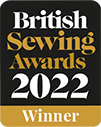
Sometimes we might find ourselves working with a fabric that has a little too much drape, causing sagging or drooping, in a project that requires something a little more stable. Interfacing, a thin but structured material, may be added to your fabric to give it a more stable handle. If you’re new to sewing, you might not have ever encountered interfacing before, so it’s important you are aware of the different types and how they can be used to make your projects easier to sew. As well as on large panels of fabric, interfacing is popularly used to stiffen specific pieces of a garment, such as cuffs, collars, yokes and waistbands.
What are the different types of interfacing?
You can get quite a few different types of interfacing, including;
- Iron-on Interfacing:Also known as ‘fusible interfacing’. This is covered in tiny dots of adhesive which melt and stick the interfacing to your fabric. This type of interfacing often adds a little more structure as the glue dots create a slight crispness.
- Sew-in Interfacing:Good for fabrics which cannot have heat applied to the surface. To use this type of interfacing you simply cut an extra pattern piece from the interfacing and apply by sewing in at the seams, along with your garment fabric.
- Woven/Non-woven Interfacing:Woven interfacing can provide a slight texture, whereas non-woven is smooth and paper-like.
- Knit Interfacing:Has a slight stretch/ease for application onto stretch, knit or jersey fabrics.
- Black/White Interfacing:Interfacing comes in different colours to ensure that the fabric used in your garment does not change colour once interfaced. White is perfect for slightly sheer or light fabrics, and Black is good for dark or opaque fabrics.
- Lightweight / Heavyweight Interfacing:All types of interfacing are available in a variety of weights, so that you can find one suitable for your fabric. Lightweight works well on Chiffon, Organza and Georgette, Medium weight on Cotton, Viscose and Polyester and Heavyweight on Corduroy, Canvas and Denim.
The interfacing you choose will always depend on the type and colour of fabric you are using.
Try and ensure that the interfacing you use is a similar weight to the fabric you’re sewing with, as anything lighter will provide little structure and anything too heavy will make your fabric too rigid. Ideally, keep a small stash of light and medium weight interfacing, as this will work on most fabrics used for dressmaking.
Some interfacing will have a ‘right’ and a ‘wrong’ side particularly Iron-on interfacing. Notice that the right side will be smooth which you can draw on and the wrong side will be covered in tiny dots of adhesive, meaning this is the side that will attach to your fabric. If you are sewing with a very lightweight or sheer fabric, avoid using interfacing where you can and instead opt for a lightweight net or organza, which you apply like sew-in interfacing.
Using iron on interfacing:
You Will Need:
- Iron and Ironing Board
- Iron-on Interfacing
- Fabric
- Pattern Pieces
- Scissors
- Pressing Cloth
If the pattern pieces you are using to cut your interfacing are fairly simple, then begin by using the pattern as a template to cut the interfacing. You can do this by pinning the pattern on or by tracing round the pattern piece using a pen on the non-sticky side of your interfacing. Cut out the pieces of interfacing that your pattern requires.
If your pattern pieces are a curve, or a more complex shape, you can cut a larger piece of interfacing to apply to your fabric prior to cutting any of your pattern pieces out. This may waste a little fabric but is good if your fabric is slippery or there are complicated shapes to match interfacing and fabric together. Once you have applied the interfacing, cut your pattern pieces as normal.
Regardless of your chosen method, the next step is the same. Place your fabric piece or panel on your ironing board, with the wrong side facing up. Position your interfacing on top of your pattern piece or fabric, with the glue side faced down. Put a pressing cloth on top of your fabric and interfacing, this could be muslin, calico or even a clean tea towel! Gently press down and apply slight pressure onto the fabric, with a hot, dry iron for a few seconds to allow the adhesive to melt.
Avoid using steam as this can prevent your interfacing from sticking and try not to move the iron around with pressure, as this will make your pieces move away from each other.
Instead, use firm pressing motions from above, keeping the iron static.
Make sure that the sticky side of your interfacing does not touch your iron directly at any moment, as this will leave burnt glue marks on your iron that don’t come off easily!
That’s all there is to it! Iron-on interfacing is perhaps the easiest type of interfacing to apply.
To see our full range of fabrics, please click here.
Make sure to tag us @poundfabrics and show us your creations on Instagram, Facebook and Twitter!
Copyright © 2019 Pound Fabrics. All Rights Reserved











Leave a comment (all fields required)